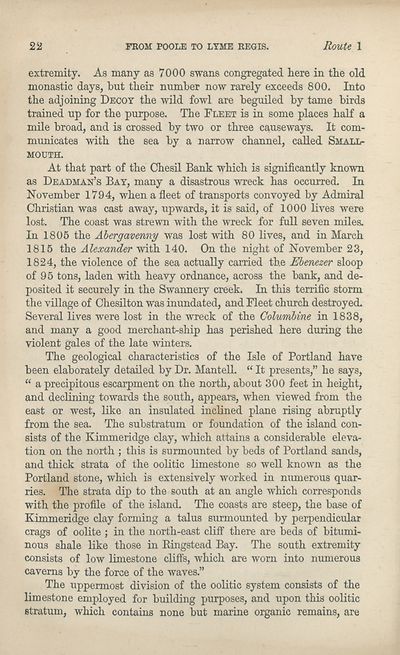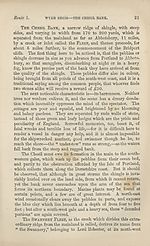Download files
Complete book:
Individual page:
Thumbnail gallery: Grid view | List view

22
FROM POOLE TO LYME REGIS.
Route 1
extremity. As many as 7000 swans congregated here in the old
monastic days, hut their number now rarely exceeds 800. Into
the adjoining Decoy the wild fowl are beguiled by tame birds
trained up for the purpose. The Fleet is in some places half a
mile broad, and is crossed by two or three causeways. It com¬
municates with the sea by a narrow channel, called Small-
mouth.
At that part of the Chesil Bank which is significantly known
as Deadman’s Bay, many a disastrous wreck has occurred. In
November 1794, when a fleet of transports convoyed by Admiral
Christian was cast away, upwards, it is said, of 1000 lives were
lost. The coast was strewn with the wreck for full seven miles.
In 1805 the Abergavenny was lost with 80 lives, and in March
1815 the Alexander with 140. On the night of November 23,
1824, the violence of the sea actually carried the Ebenezer sloop
of 95 tons, laden with heavy ordnance, across the bank, and de¬
posited it securely in the Swannery creek. In this terrific storm
the village of Chesilton was inundated, and Fleet church destroyed.
Several lives were lost in the wreck of the Columbine in 1838,
and many a good merchant-ship has perished here during the
violent gales of the late winters.
The geological characteristics of the Isle of Portland have
been elaborately detailed by Dr. Mantell. “ It presents,” he says,
“ a precipitous escarpment on the north, about 300 feet in height,
and declining towards the south, appears, when viewed from the
east or west, like an insulated inclined plane rising abruptly
from the sea. The substratum or foundation of the island con¬
sists of the Kimmeridge clay, which attains a considerable eleva¬
tion on the north ; this is surmounted by beds of Portland sands,
and thick strata of the oolitic limestone so well known as the
Portland stone, which is extensively worked in numerous quar¬
ries. The strata dip to the south at an angle which corresponds
with the profile of the island. The coasts are steep, the base of
Kimmeridge clay forming a talus surmounted by perpendicular
crags of oolite ; in the north-east cliff there are beds of bitumi¬
nous shale like those in Ringstead Bay. The south extremity
consists of low limestone cliffs, which are worn into numerous
caverns by the force of the waves.”
The uppermost division of the oolitic system consists of the
limestone employed for building purposes, and upon this oolitic
stratum, which contains none but marine organic remains, are
FROM POOLE TO LYME REGIS.
Route 1
extremity. As many as 7000 swans congregated here in the old
monastic days, hut their number now rarely exceeds 800. Into
the adjoining Decoy the wild fowl are beguiled by tame birds
trained up for the purpose. The Fleet is in some places half a
mile broad, and is crossed by two or three causeways. It com¬
municates with the sea by a narrow channel, called Small-
mouth.
At that part of the Chesil Bank which is significantly known
as Deadman’s Bay, many a disastrous wreck has occurred. In
November 1794, when a fleet of transports convoyed by Admiral
Christian was cast away, upwards, it is said, of 1000 lives were
lost. The coast was strewn with the wreck for full seven miles.
In 1805 the Abergavenny was lost with 80 lives, and in March
1815 the Alexander with 140. On the night of November 23,
1824, the violence of the sea actually carried the Ebenezer sloop
of 95 tons, laden with heavy ordnance, across the bank, and de¬
posited it securely in the Swannery creek. In this terrific storm
the village of Chesilton was inundated, and Fleet church destroyed.
Several lives were lost in the wreck of the Columbine in 1838,
and many a good merchant-ship has perished here during the
violent gales of the late winters.
The geological characteristics of the Isle of Portland have
been elaborately detailed by Dr. Mantell. “ It presents,” he says,
“ a precipitous escarpment on the north, about 300 feet in height,
and declining towards the south, appears, when viewed from the
east or west, like an insulated inclined plane rising abruptly
from the sea. The substratum or foundation of the island con¬
sists of the Kimmeridge clay, which attains a considerable eleva¬
tion on the north ; this is surmounted by beds of Portland sands,
and thick strata of the oolitic limestone so well known as the
Portland stone, which is extensively worked in numerous quar¬
ries. The strata dip to the south at an angle which corresponds
with the profile of the island. The coasts are steep, the base of
Kimmeridge clay forming a talus surmounted by perpendicular
crags of oolite ; in the north-east cliff there are beds of bitumi¬
nous shale like those in Ringstead Bay. The south extremity
consists of low limestone cliffs, which are worn into numerous
caverns by the force of the waves.”
The uppermost division of the oolitic system consists of the
limestone employed for building purposes, and upon this oolitic
stratum, which contains none but marine organic remains, are
Set display mode to:
![]() Universal Viewer |
Universal Viewer | ![]() Mirador |
Large image | Transcription
Mirador |
Large image | Transcription
| Antiquarian books of Scotland > Adventure and adventurers > Black's guide to Dorsetshire > (38) |
|---|
| Permanent URL | https://digital.nls.uk/116814368 |
|---|
| Description | Thousands of printed books from the Antiquarian Books of Scotland collection which dates from 1641 to the 1980s. The collection consists of 14,800 books which were published in Scotland or have a Scottish connection, e.g. through the author, printer or owner. Subjects covered include sport, education, diseases, adventure, occupations, Jacobites, politics and religion. Among the 29 languages represented are English, Gaelic, Italian, French, Russian and Swedish. |
|---|

